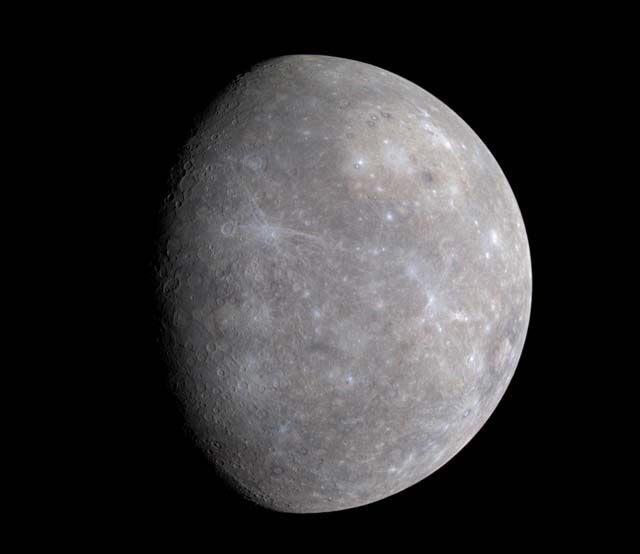The rotation of Mercury is a little strange to Earth bound creatures. It rotates on its axis very slowly compared to its orbital period. One rotation takes 56.85 Earth days, while one orbital period only takes 88 Earth days. This means that a single day on Mercury last about 0.646 times as long as a single year. The planet’s equatorial rotational speed is 10.892 km/h. These periods are given in solar days. In sidereal days Mercury rotates every 58.647 days and orbits twice during every three rotations.
At some places on Mercury’s surface, an observer could see the Sun rise about halfway, reverse its course, then set, all over the course of one Mercurial day. This happens about four days prior to perihelion, because Mercury’s angular orbital velocity is equal to its angular rotational velocity. This causes the apparent motion of the Sun to stop. Once Mercury achieves perihelion, its angular orbital velocity exceeds the angular rotational velocity and the Sun begins to move in reverse. That is a simplification of sorts, so here is another way to explain this, in a little more detail: During one Mercurian year, the average motion of the Sun is two degrees per day to the west(one-third of the stars’ motion of six degrees per day) making the day three times longer than the rotation period. At different times of that year, the motion varies. When nearing aphelion, the orbital motion is slower, and the net westward motion of the Sun is more than 150% its normal angular velocity, or more than three degrees per day. On the other hand, when approaching perihelion, the Sun slows, stops moving westward, moves a little over one diameter to the east, then starts slowly moving westward again, faster and faster, until the Sun is going more than three degrees per day to the west, at the next aphelion. At the same time that the Sun is changing speeds, it gets larger, and then smaller, because its apparent size depends upon how far away it is.
The rotation of Mercury was not discovered until 1965. Until then the most widely accepted theory had Mercury tidal locked to the Sun. Soviets scientists bounced radar signals off the planet’s surface in 1962 verifying that the planet rotated, but it wasn’t until scientists using the Arecibo Observatory verified the planet’s sidereal rotational period of 58.647 day.
We have written many articles about Mercury for Universe Today. Here’s an article about Mercury retrograde, and here’s an article about the size of Mercury.
If you’d like more information on Mercury, check out NASA’s Solar System Exploration Guide, and here’s a link to NASA’s MESSENGER Misson Page.
We’ve also recorded an entire episode of Astronomy Cast all about Mercury. Listen here, Episode 49: Mercury.
References:
NASA Solar System Exploration: Mercury
Wikipedia
cseligman.com


If the earth loses one second every year in its daily rotation, and eighty-six thousand four hundred years ago a day was zero minutes long, how close was the earth to the sun?